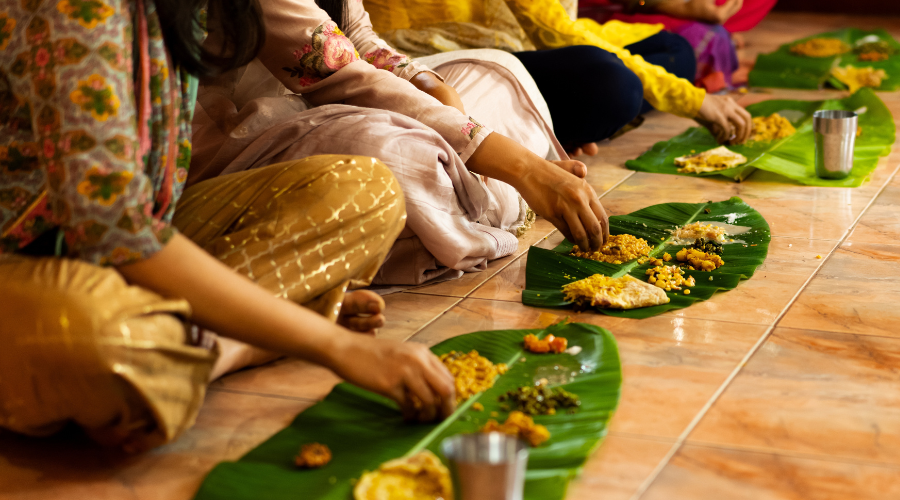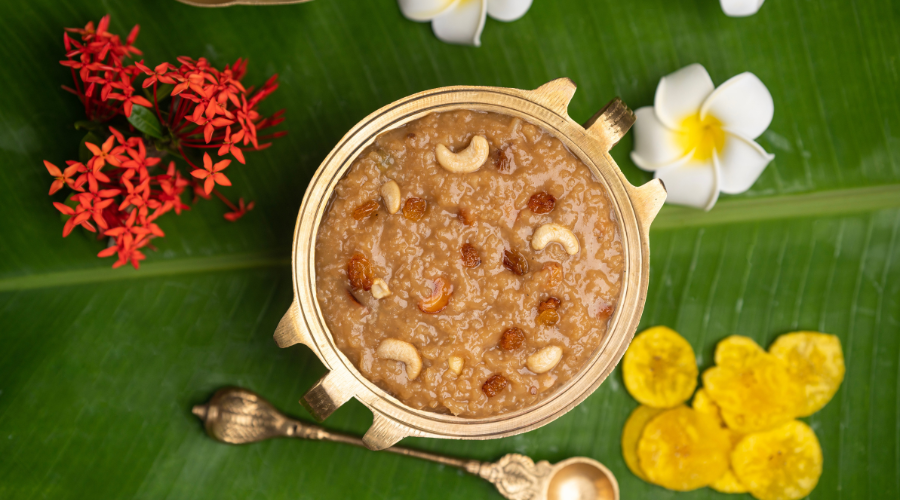A Sadhya is more than just a feast; it is a celebration of balance, community, and tradition, laid out in meticulous order on a humble banana leaf. Rooted in Kerala’s agrarian history and temple culture, this festive spread carries with it centuries of ritual. From the placement and order of serving to the etiquette of savouring each dish by hand, every detail is an experience woven with symbolism, reflecting values of gratitude, harmony, and connection.
Every dish in a Sadhya has a designated spot. Pickles, salt, and banana chips take their places on the top left, while thorans, avial, and thiyal are arranged in neat order. Rice sits at the center, waiting for ladles of parippu, sambar, and rasam to follow one after the other. The logic is both practical and cultural: sour, salty, spicy, and sweet elements are sequenced so that no taste overpowers the other. This carefully arranged meal is mindfully balanced.
Hear From A Chef
Chef Sukesh Krishnan, executive chef, Gateway Bekal, Kerala, says that the charm of a traditional Kerala Sadhya lies in its remarkable variety and the sacred customs preserved over centuries. “Each Sadhya is served with the banana leaf positioned so its narrow end points to the left, a gesture signifying reverence for tradition. Our main dishes are prepared in massive urulis—the traditional cooking vessels that have been a staple in Kerala kitchens across generations.”
“The serving follows an age-old tradition, starting at the top left corner of the leaf with items such as yellow banana, sarkara upperi, and papadam, followed by a carefully ordered selection of pickles and vegetable dishes including thoran, olan, avial, and erissery,” he added. The highlight of the feast arrives when piping hot sambar and parippu are poured generously over the fragrant red rice.
What ties every dish together is coconut— Kerala’s treasured ingredient. From creamy curry bases made with coconut milk to authentic flavours carried by coconut oil, this reflects the natural bounty of the land. “Partaking in a Sadhya is far more than dining; it is embracing a cultural ritual that binds you to Kerala’s rich agricultural heritage and traditions,” said chef Krishnan.
The Right Way To Eat Sadhya
Traditionally, Sadhya is eaten with the right hand, fingers delicately mixing rice with curries and gravies before bringing it to the mouth. The act is more than functional—it is tactile, engaging all senses, and considered to aid digestion. It is said that eating with hands connects the body to the food and the food to the earth, reinforcing the cycle of nourishment.

Sadhya is rarely eaten alone. Whether during Onam, Vishu, weddings, or temple festivals, rows of people sit cross-legged, served together in unison. There is no hierarchy at the leaf; everyone is equal before the meal. Servers move swiftly with buckets of rice and ladles of curries, ensuring no leaf runs dry. This communal dining emphasises shared joy, hospitality, and the idea that abundance multiplies when shared.
The roots of the Sadhya stretch deep into Kerala’s temple culture. Historians believe that temple feasts, where food was served to devotees as prasadam, laid the foundation for the Sadhya’s structure. Over time, agrarian communities added local vegetables, coconut-based gravies, and rice-based sweets like payasam, making it a reflection of Kerala’s geography and seasonal rhythms.
The Significance Of Sadhya
Speaking with Outlook, art curator and author Tanya Abraham reflected on the deeper cultural layers behind the Sadhya. “For one, the banana leaf speaks of an agrarian society and its practices. The leaf is also known for its qualities of promoting wellness as per ayurveda. The Sadhya thus symbolises the very core of Kerala living and its deep rooted connection to local practices such as ayurveda and the embracing of nature.”
Founder of The Art Outreach Society, Tanya Abraham has long explored Kerala’s cultural history. Her book, Eating With History: Ancient Trade-Influenced Cuisines of Kerala, traces this journey. She explains that the Sadhya, once a royal custom, gradually evolved into a community tradition, becoming inseparable from Onam and its commemoration of King Mahabali’s arrival.
“One ought to remember that Onam is not a religious festival— it is a social celebration across all religions and communities, and remains the thread that connects Malayalis irrespective of their socio-cultural backgrounds. If we look at Kerala’s history, it was one that welcomed “outsiders”, be it the Arabs or the Jews. Onam acts as a celebration which brings unity and has always been a catalyst for communal harmony,” Abraham commented.
A Sadhya always concludes with payasam, sometimes two or three varieties, poured directly onto the leaf or served in cups. The sweetness signifies auspicious endings and new beginnings, reminding diners that life, like the meal, is meant to be savoured fully.
Read More: Tracing The Roots Of Chettiars, Their Culture, And Cuisine
Also Read: Onam 2025: Check Out The Best Onam Sadhya in Delhi, Mumbai, Bangalore, And Kolkata









